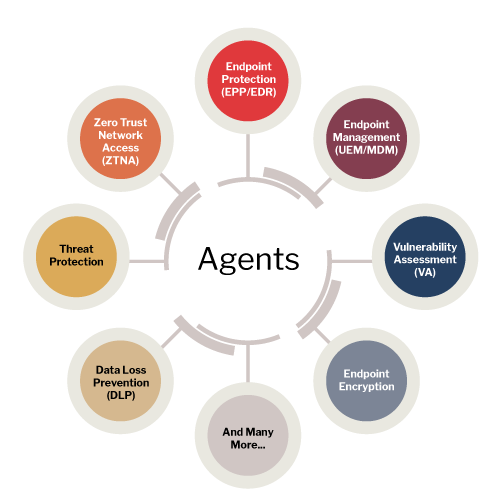Coverage Gap Analysis
According to industry reports, 2% of agents fail per week, and 42% of endpoints are unprotected in some manner at any given time1. This leads to a lack of confidence in security control coverage and compliance with standards such as CIS, NIST, ISO 27001, PCI-DSS, HIPAA and SOC 2.
COVERAGE GAPS
Malfunctioning Agents
28% of endpoints are unprotected due to broken or outdated agents1
Missing Agents
12% of endpoints remain unprotected by endpoint protection agents2
Misconfigured Agents
19% of agents require at least one repair within 30 days3
Maximize Security Controls and Agent Coverage
Validate that security and management agents are deployed and functioning across endpoints as they should be, identify coverage gaps, and control your attack surface with Oomnitza.
“Oomnitza serves as a gatekeeper to ensure that the suite of security agents we want to be deployed across our environment are actually deployed and running correctly. It stitches together all of our different security tools on our endpoints.”
Nemi George
VP, Information Security Officer & IT Operations
Pacific Dental Services
It’s All About Endpoint Agents
As traditional network perimeters give way to hybrid-work and cloud-based models, you rely heavily on a suite of agents for endpoint protection (EPP), endpoint and mobile device management (UEM/MDM), encryption, vulnerability assessment (VA), data loss prevention (DLP), zero trust network access (ZTNA), threat response and more. Agents have become a cornerstone of your endpoint management and security programs.

Challenges
- Lack of confidence in policy vs. reality of endpoint security and compliance controls
- FTE time spent exporting data from many siloed systems and correlating manually
- Friction between security & IT teams due to lack of or inaccurate endpoint compliance reporting
Agent Coverage Gaps are a Big Blind Spot
Agents only provide visibility and control where they are correctly deployed and functioning. Coverage gaps occur when agents:
- Are not deployed on all endpoints
- Aren’t running the correct versions
- Don’t have the latest security updates
- Aren’t correctly configured
- Haven’t communicated back to their management consoles
Agent-based management consoles are not good at showing you gaps in coverage. With 10 or more security agents2 installed on every endpoint, manually consolidating and correlating data scattered across multiple siloed systems to compile accurate agent coverage is arduous, resource-intensive and error-prone.
Identify Whether or Not Your Agents Are Present and Performing
Oomnitza integrates with all your IT and security tools, automatically aggregates and correlates data from these systems, and gives you insight into where agents are deployed, missing or malfunctioning.
- Visibility into assets whether or not an agent is present and functioning
- Integration of data from your management and security tools such as UEM/MDM, EPP, VA into one single source of truth
- Continuous monitoring of endpoint coverage and agent health
- Reporting on endpoint security posture for compliance policies & standards such as CIS, NIST, ISO 27001, PCI-DSS, HIPAA & SOC 2
- Automated workflows to take action to fix security exposures and compliance gaps
Benefits
- Single system for automated endpoint coverage gap identification and reporting
- Confidence in endpoint compliance policies and controls being met
- Reduction in security exposures and attack surface
- FTE cost savings by eliminating manual efforts to support audit processes
- Improved alignment and collaboration between security and IT teams
Explore Additional Use Cases
Onboarding
Automate employee onboarding to improve IT efficiency and increase employee productivity, engagement and job satisfaction.
Offboarding
Streamline and strengthen every step of the offboarding process. Perform actions and set up automated workflows within a single platform.
Readiness
Automate audit readiness and compliance validation to increase risk mitigation efficacy and reduce audit delays, gaps, costs and penalties.
Forecasting
Automate lifecycle management processes for all technology assets to improve IT budgeting, forecasting and procurement.
Management
Automate SaaS lifecycle processes to improve utilization, mitigate cyber risk and eliminate wasteful spend.
Conductor
Orchestrate across your existing infrastructure tools to automate key business processes, increase IT efficiency and improve decision making.
& Hygiene
Continuously achieve data accuracy across your entire technology asset-portfolio.
Related Resources



Experience Oomnitza Up Close
Schedule a demo with one of our Enterprise
Technology Management experts today.